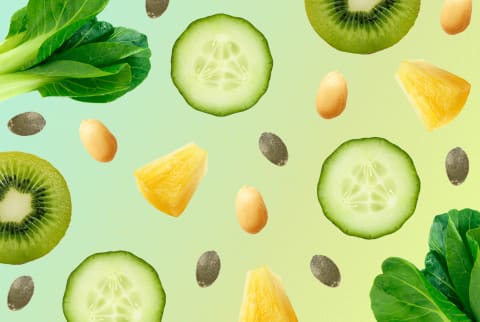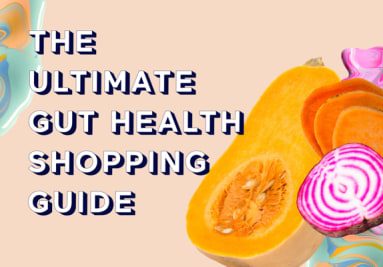FODMAPs tend to be short carbohydrate chains and are easily fermentable by bacteria in the small intestine. Fermentation increases gas production and draws water into the colon, which leads to distention, bloating, stomach pain, gas, and discomfort, ultimately resulting in constipation or diarrhea. While the diet typically helps 50% to 80%2 of people who follow it, there are still others who don’t get these positive results. If you’re among these people, it can be frustrating and confusing. Here are some reasons that may explain why the diet didn’t work for you and additional things you can consider trying. You may have grabbed gluten-free crackers or salad dressing that also have dehydrated or powdered onion or garlic. Or maybe you had a healthy energy bar that is sweetened with pear or apple concentrate. Even a small amount of these ingredients can cause a problem. Even if you are being careful about hidden sources of FODMAPs, it is important to remember that FODMAPs can have a bucket-like effect, which means, when you eat carbohydrates with FODMAPs you slowly add to the bucket and gradually get closer to a threshold after which symptoms start to appear. The threshold varies from one person to another. So, if you eat half a cup of roasted broccoli with two Brussels sprouts and sprinkle 2 tablespoons of pine nuts on top, you could trigger symptoms even though all are within the allowed portion limit for each food. Nuts, leafy greens, and raw vegetables may be difficult to digest due to their hard cell walls. Instead, try soaking nuts, sticking to nut and seed butters only, or removing them altogether. Avoid raw salads and cook all vegetables, especially leafy greens. Cook meats in liquid, for example by simmering or making a stew, as these will be easier to digest compared to dry grilled pieces. High fat intake can slow down gastric emptying and give you the feeling of indigestion and bloating. If your liver and gallbladder don’t make and release enough bile salts, you may not absorb fats and oils properly, which will lead to diarrhea or loose stool. Food sensitivities, on the other hand, are completely different immune reactions that often trigger subtle, delayed, and less severe symptoms. When immune cells can’t recognize certain foods as “safe” anymore and tag them as foreign, they start to attack by releasing inflammatory compounds like cytokines, leukotrienes, histamine, and others. This immune-inflammatory response to food can contribute to symptoms like bloating, water retention, gas, stomach pain, and diarrhea. Food sensitivities often come with other symptoms like brain fog, muscle and joint pain, fatigue, headache, and mood swings. If you have followed the low-FODMAPs diet strictly but didn’t feel significant improvement in your symptoms, it’s possible you have an immune response to foods that are allowed. You may be reacting to salmon, chicken, blueberries, cucumber, parsley or any other “safe” low-FODMAP food. Or your immune system may be reacting to the casein in dairy, not just the lactose. If the diet made you feel worse, you may have started eating a food that you have a sensitivity to more often because it’s allowed on the diet, and that ended up backfiring. A healthy body can keep histamine levels in check. There are two enzymes that help break down histamine, and one of them is mostly produced in the gut. For a variety of reasons, including certain medications, gut infections, and dysbiosis, these enzymes don’t work properly, and your body loses the ability to get rid of excess histamine. The result is a condition known as histamine intolerance. Histamine intolerance symptoms include redness or flushing in the skin, eczema, rashes, hives, sneezing, congestion, postnasal drip, low blood pressure, rapid heart rate, nausea, vertigo, dizziness, headaches, migraines, muscle and joint pain, insomnia, and other mysterious symptoms. The low-FODMAPs diet can reduce histamine levels4 in the body. While this is a point in favor of the diet, if you have histamine intolerance, you’re probably still taking in too much histamine from food without knowing it. Aged hard cheeses, vinegar, tomato, eggplant, spinach, bone broth, and canned tuna are high in histamine, despite being low in FODMAPs. And eggs, strawberries, oranges, banana, pineapple, some nuts, tomatoes, eggplant, spinach, and shellfish can stimulate your body to make more histamine. Leftover foods, even a day or two later, can accumulate enough histamine to trigger symptoms. On top of that, having food sensitivities means that your body is releasing histamine, along with other immune compounds, as a reaction to foods, regardless of their histamine or FODMAPs levels. It’s estimated that 4% to 78% of people with IBS have SIBO5. It’s more common in people with IBS who are female, older, have diarrhea-predominant IBS, experience bloating and gas, and have used proton-pump inhibitors or narcotics. The low-FODMAPs diet tends to help people who have SIBO. However, they may need additional dietary restrictions, such as removing all starches, grains, legumes, and sugars. People with SIBO also have a hard time with the reintroduction phase. Because the presence of bacteria in the small intestine isn’t addressed with the elimination diet alone, adding back foods that are easily fermented will bring on the symptoms again. The diet can affect the composition of the gut microbiome, which can lead to other health implications later. One study found that following the low-FODMAPs diet for 21 days reduced total bacteria abundance6 in the gut. Another study found that four weeks on the low-FODMAPs diet reduced bifidobacteria7, a beneficial type of bacteria that prevents infections and produces B vitamins and short-chain fatty acids (SCFA). Eating nutrient-rich, high-fiber foods like apples, pears, cauliflower, celery, onion, garlic, artichoke, and others is important for maintaining a healthy gut and preventing many chronic diseases.




